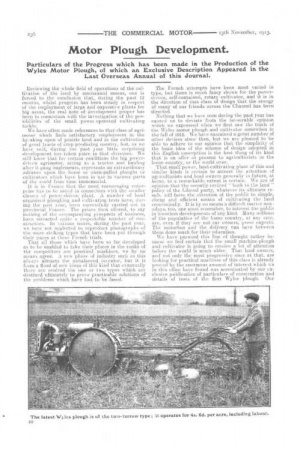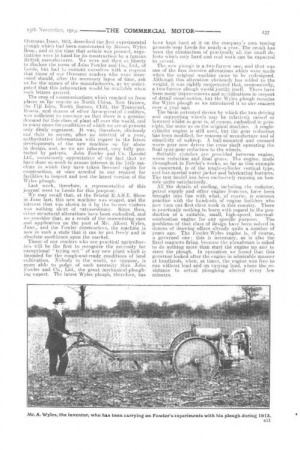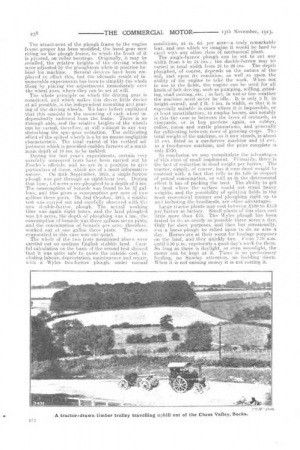Motor Plough Development.
Page 4

Page 5

Page 6

If you've noticed an error in this article please click here to report it so we can fix it.
Particulars of the Progress which has been made in the Production of the Wyles Motor Plough, of which an Exclusive Description Appeared in the Last Overseas Annual of this Journal.
Reviewing the whole field of operations of the cultivation of the land by mechanical means, one is forced to the conclusion that, during the past 12 months, whilst progress has been steady in respect of the employment of large and expensive plants for big areas, the real note of development proper has been in connection with the investigation of the possibilities of the small power-operated cultivating tackle.
We have often made references to that class of agrimotor which finds satisfactory employment in the kneaking open of prairie land and in the cultivation of great tracts of crop-producing country, but, as we have said, during the past year little surprising development has taken place in that direction. We still know that for certain conditions the big powerdriven agrimotor, acting as a tractor and hauling after it gang implements, represents an extraordinary advance upon the horse or oxen-pulled ploughs or cultivators which have been in use in various parts of the world from time immemorial. It is in France that the most encouraging enterprise has to be noted in connection with the smaller classes of power-driven plant. A number of local organized ploughing, and cultivating tests have, during the past year, been successfully carried out in provincial France. The prizes then offered, to say nothing of the accompanying prospects of business, have attracted quite a respectable number of constructors. In various issues, during the past year, we have not neglected to reproduce photographs of the more striking types that have been put through their paces at these French trials.
That all those which have been so far developed as to be enabled to take their places in the ranks of the competitors are practical machines, we by no means agree. A new phase of industry such as this always attracts the unbalanced inventor, but it is from a flood of new ideas of this kind that eventually there are evolved the one or two types which are destined ultimately to prove practicable solutions of the problems which have had to be heed. The French attempts have been most varied in type, but there is much fancy shown for the powerdriven, self-contained, rotary cultivator, and it is in the direction of that class of design that the energy of many of our friends across the Channel has been directed.
Nothing that we have seen during the past year has caused us to deviate from the favourable opinion which we expressed when we first saw the trials of the Wyles motor plough and cultivator somewhen iii the fall of 1912. We have examined a great number of other devices since then, but we are pleased to be able to adhere to our opinion that the simplicity of the basic idea of the scheme of design adopted in this English conception is the best thing of its kind that is on offer at present to agriculturists in the home country, or the world over.
That small power, land-cultivating plant of this and eimilar kinds is certain to attract the attention of agriculturists and land owners generally in future, at home, to a remarkable extent is certain. We are of opinion that the recently-revived " back to the land " policy of the Liberal party, whatever its ultimate result, will force the attention of the public to simple, cheap and efficient means of cultivating the land economically. It is by no means a difficult matter nowadays, too, one must remember, to interest the public in borseless developments of any kind. Many millions of the population of the home country, at any rate, are, even if they are not car owners, qweii experts. The motorbus and the delivery van have between them done much for their education.
We have pursued this line of thought rather because we feel certain that the small machine-plough and cultivator is going to receive a lot of attention before the world is much older. That land owners, and not only the most progressive ones at that, are looking for practical machines of this class is already proved by the enormous amount of interest which we in this office have found was accentuated by our exclusive publication of particulars of construction and details of tests of the first Wyles plough. Our Overseas Issue, 1913, described the first experimental plough which had been constructed by Messrs. Wyles Bros., and at the time that article was penned, negotiations weae in hand for its construction by a famous British manufacturer. We were not then at liberty to disclose the name of John Fowler and Co., Ltd., of Leeds, but had to content ourselves with a request that those of our Overseas readers who were interested should, after the necessary lapse of time, ask us for the names of the manufacturers, as we anticipated that this information would be availnble when such letters arrived.
The crop of .eommunications which reached us from plates so far remote as North China, New Guinea, the Fiji Isles, North Borneo, Chili., the Transvaal, Russia, and +dozens of other far-separated localities, was sufficient to convince us that there is a genuine demand for this class of plant all over the world, and in many cases for conditions of which we are at present only dimly cognizant. It was, therefore, obviously our duty to secure, after an interval of a year, authoritative information with regard to the latest developments of the new machine .so far alone in design, and, as we are informed, very fully protected by patents. John Fowler and Co. (Leeds) Ltd., courteously appreciative of the fact that we have done so much to arouse interest in the little machine in which they have taken licensed rights for construction, at once acceded to our request for facilities to inspect and test the latest version of the Wyles plough.
Last week, therefore, a representative of this journal went to Leeds for this purpose.
We may recall that, at the Bristol .R.A.S.E. Show in June last, this new machine was staged, and the intel est that was shown in it by the fa mer visitors was nothing short of extraordinary. Since then, other structural alterations have been embodied, and we consider that, as a result of the unremitting care and. application on the part of Mr. Albert Wyles, ;Vann, and the Fowler constructors, the machine is now in such a. state that it can be put freely and in absolute confidence upon the market.
Those of our readers who are practical agriculturists will be the first to recognize the necessity for exceptional " trying out " of any new plant which is intended for the rough-and-ready conditions of land cultivation. Nobody in the world, we suppose, is more able to judge of such necessity than John Fowler and Co., Ltd., the great mechanical-ploughma expert. The latest Wyles plough, therefore, has been kept hard at it on the company's own testing grounds near Leeds for nearly a year. The result has been the elimination of practically all the small defects which only hard and real work can be expected to reveal.
The new plough is a two-furrow one, and that was one of the first decisive alterations which were made when the original machine came to be redesigned. Although this alteration obviously has added to the weight, it was rightly conjectured that, economically, a two-furrow plough would justify itself. There have been many improvements and modifications in respect of detail construction, but the Wyles plough remains the Wyles plough as we introduced it to our readers over a year ago.
The basic patented device by which the two driving and supporting wheels may be. relatively raised or lowered whilst in gear is, of course, embodied in principle, the same as oil the original machine. A singlecylinder engine is still used, but the gear reduction has been modified, for reasons of manufacture and of simplicity of upkeep. A ball-mounted and encased worm gear now drives the cross shaft operating the final spur-gear reduction to the wheels.
Suitable clutches are provided between engine, worm reduction and final gears. The engine, made throughout in Fowler's works, so far as this example is concerned, is of the single-cylinder vertical type, and has special water jacket and lubricating features. The test model has been exclusively running on bensole quite satisfactorily. All the details of cooling, including tile radiator, pettol supply and other engine features, have been brought into line with what, of course, is common practice with the hundreds of engine builders who now turn out first-class work in this country. There is practically nothing to learn with regard to the production of a suitable, small, high-speed, internal
combustion engine for any specific purpose. The problems of that class of design have been solved in dozens of drawing offices already quite .a number of years ago. The Fowler-Wyles engine is,. of course, a governed one this is necessary, as is also the fixed magneto firing, because the ploughman is asked to do nothing more than start the. engine up and to
I steer the plough. n operation we found that this governor looked after the engine in admirable manner at headlands, when, at times, the engine was free to run without load and on varying land, where the resistance to actual ploughing altered every few minutes. The attachment of the plough frame to the engine frame proper has been modified, the hand gear now riding on the plough frame, to which the front of it is pivoted, on roller bearings. Originally, it may be recalled, the relative heights of the driving wheels were adjusted by the ploughman when in position be
hind his machine. Several devices have been employed to effect this, but the ultimate result of innumerable experiments has been to simplify the whole thing by placing the adjustments immediately over the wheel axes, where they can be set at will.
The whole principle on which the driving gear is conceived, and which makes this clever little device at all possible, is the independent mounting and gearing of the driving wheels. We have before explained that this consists in the mounting of each wheel independently radiused from the frame. There is no through axle, and the relative heights of the wheels can be varied, therefore, at will without in any way disturbing the spur-gear reduction. The cultivating effect of the spiked wheels is a by no means negligible characteristic. The total extent of the vertical adjustment which is provided enables furrows of a maximum depth of 10 ins, to be tackled.
During the last year's experiments, certain very carefully measured tests have been carried out by Fowlem 's officials, and we are in a position to give particulars of these, which ate. of amost informative
nature. On 26th September, 1913, a single-furrow plough WAS put through an eight-hour test. During that time, 1.6 acres were ploughed to adepth of 6 ins. The consumption of benzoic was found to be 31 gallons, and this gives a consumption per acre of two gallons three pints. On 2nd October, 1913, a similar test was carried out and carefully observed with the new double-furrow plough. The actual working time was again eight hours, and the land ploughed was 2.8 acres, the depth of ploughing was 5 ins., the consumption of benzoIe was three gallons seven pints, and the consumption of benzole per acre, therefore, worked out at one gallon three pints. The water evaporated in this ease was one quart.
The whole of the two tests mentioned above were carried out on medium English stubble land. Careful calculation on the basis of the second test showed that it was quite safe to quote the outside cost, including labour, depreciation, maintenance and repair, with a Wyles two furrow plough, under normal conditions, at 4s. 601. per acre—a truly remarkable feat, and one which we imagine it would be hard to excel with any other class of mechanical plant. The single-furrow plough can be set to cut any width from 8 to 14 ins. ; the double-furrow may be varied in total width from 16 to 22 ins. The depth ploughed, of course, depends on the nature of thesoil, and upon its condition, -as well as upon the ability of the engine to take the work. When not in use in the fields, the engine can be used for all kinds of belt driving, such as pumping, milling, grinding, chaff cutting, etc. ; in fact, in wet or fine weather the machine need never be idle. It is only 3 ft. in height overall, and 2 ft. 4 ins_ in width, so that it is especially suitable in cases where it is impossible, or at least unsatisfactory, to employ horses, and notably is this the case in between the trees of orchards, in vineyards, or in hop gardensagain, on rubber, coffee, cocoa and wattle plantations, and generally for cultivating between rows of growing crops. Th_i total weight of the machine, as it now stands, is about 13 cwt. fitted as a one-furrow machine and 14 cwt. as atwo-furrow ma-chine, and the price complete is only £130. In conclusion we may recapitulate the advantages 0r this class of small implement. Primarily, there is the fact of reduction in dead weight per furrow. The tractor, simply, of course, has it own dead weight to contend with, a fact that tells us its tale in respect of petrol consumption, as well as in the detrimental effect it has of packing the land. The ability to get to land where the surface would not stand heavy weights, and the possibility of splitting fields in the most economical manner and ploughing right up to and including the headlands, are other advantages. Large tractor plants may cost between £100 to £160 per furrow at factory. Small plants of this class cost little more than £70. The Wyles plough has been tested to do as nearly as possible three acres a day. Only for show purposes, and then but occasionally, can a horse-plough be relied upon to do an acre a day. Horses are at their worst for haulage purposes on the land, and they quickly tire. From 7.20 a.111. until 3.30 p.m.. represents a good day's work for them. So long as there is daylight, or even moonlight, the motor can be kept at it. There is no preliminary feeding, no Sunday attention, no bedding down. When it is not earning money it is not costing it.
























